19 Vegetables That Start With M
This post may contain affiliate links. As an Amazon Associate, I earn from qualifying purchases. Please read my disclosure.We are continuing my A-Z food list series with this post focusing on vegetables that start with M! I love incorporating new foods into my diet, so I’m always looking for new vegetables to try. Get ready for a fabulous list of veggies starting with the letter M and recipes for inspiration!
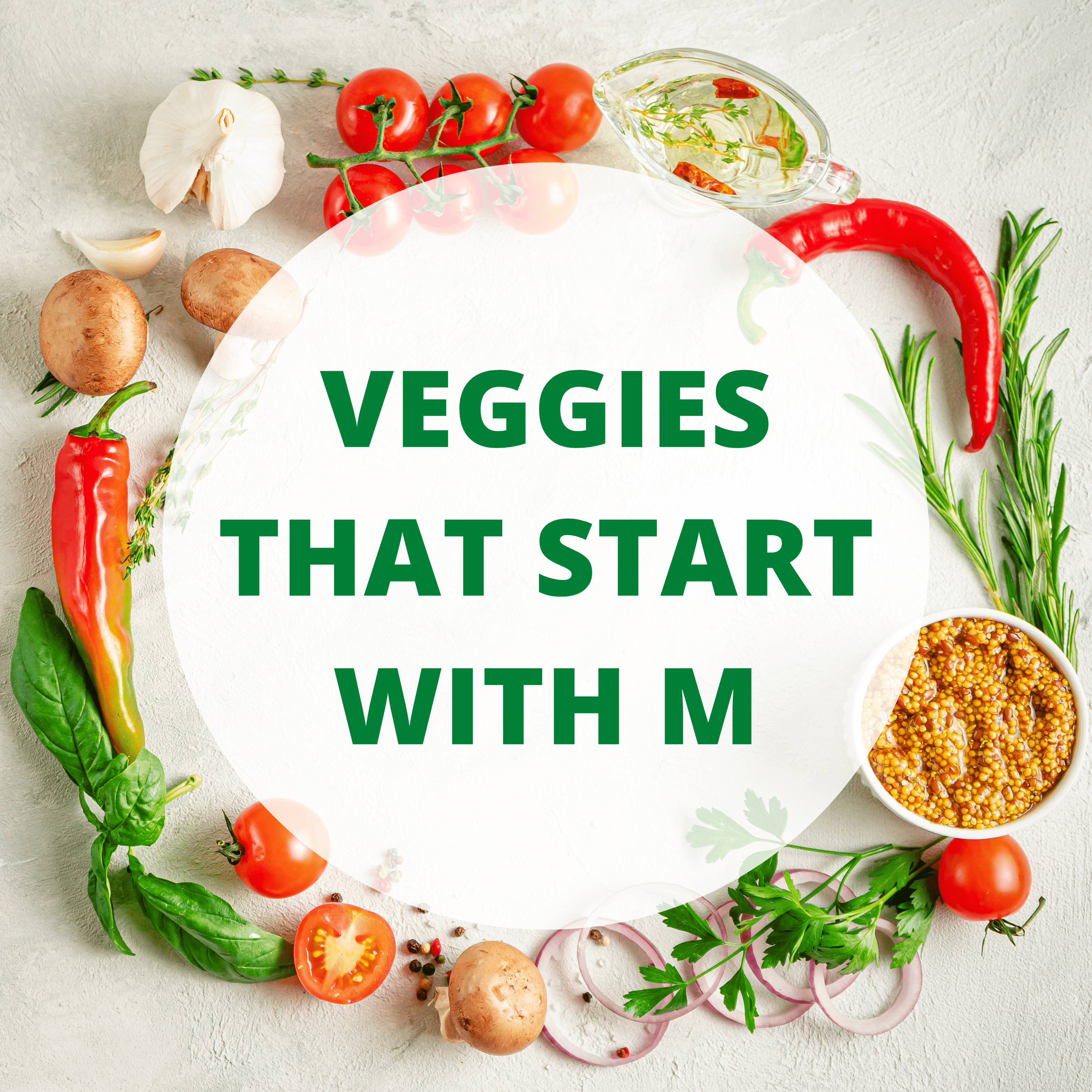
1. Maize
Let’s get right into it! Maize is the first vegetable beginning with M on our list. Here is everything you need to know.
What Is Maize?
Aside from simply being a vegetable that starts with M, maize is the scientific name of the cereal grain that most people know as corn. Having been developed over the years through a selective breeding process, maize or corn has quickly become one of the most popular vegetables in the world.
What Does Maize Taste Like?
It’s safe to say that most people are familiar with what maize tastes like. Standard sweet corn is moderately sweet and many people enjoy it fresh or with butter. Field corn doesn’t have as sweet of a taste, so it’s often ground into cornmeal or corn flour.
Is Maize Healthy?
Maize makes a great addition to any healthy diet because it is chock-full of dietary fiber. It’s one of my favorite vegetables that start with m because it’s so versatile. It’s also great for improving eyesight and contains many beneficial vitamins and minerals. Just be mindful that maize, like any cereal grain, is high in carbs (specifically starch) and contains trace amounts of sugar.
Recipes To Try!
Check out these delicious recipes that use maize:
- Corn Fries (Mexican Street Corn Style + 4 Variations!)
- Roasted Chili Corn Salsa (Chipotle Copycat Recipe!)
- Healthy Cornbread Recipe (Vegan Option!)
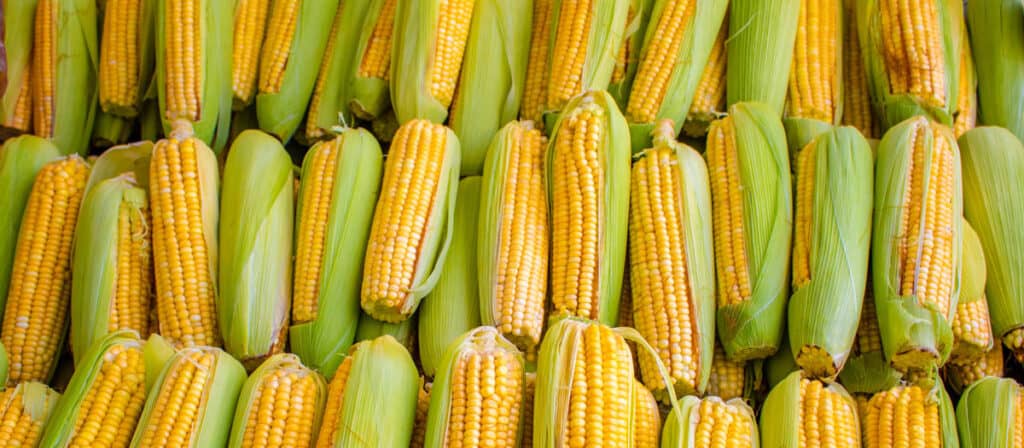
2. Malabar Spinach
Although it looks just like it, Malabar Spinach isn’t botanically true spinach. Here is how most people enjoy this leafy green type of lettuce.
What Is Malabar Spinach?
This tropical leafy green vegetable was named after a coastal region in southwestern India. The dark green, glossy, oval, or heart-shaped leaves can be eaten both raw in salads or cooked.
What Does Malabar Spinach Taste Like?
Malabar spinach has a mild, slightly peppery taste that somewhat resembles spinach or arugula. However, once it’s cooked, Malabar leaves become gluey, and the texture becomes very different from that of spinach.
Is Malabar Spinach Healthy?
The leaves of the plants are a tremendous source of vitamin C (over 3 times what traditional spinach contains), vitamin A (more than 1.5 times that of kale), calcium, potassium, and iron, making Malabar spinach a wonderful addition to a balanced diet.
Recipes To Try!
Malabar spinach tastes great in salads or cooked on the stove. Here are some recipes to try it in:
- Florentine Pizza (White Spinach Pizza)
- Roasted Cauliflower Salad with Spinach and Chickpeas
- Mushroom Toast
3. Malanga
One of the more uncommon vegetables that start with the letter M is malanga. If you aren’t familiar with it, here are some things to note.
What Is Malanga?
Malanga is a root vegetable commonly enjoyed in South America, Africa, and certain tropical regions. Its texture is somewhat similar to potatoes and it’s commonly milled into flour. However, malanga differs from potatoes in that it’s not a member of the nightshade family (which is a food source that some people avoid for health reasons).
What Does Malanga Taste Like?
Despite the fact that it looks like potatoes or sweet potatoes, malanga has an earthy and somewhat nutty taste.
Is Malagna Healthy?
Sure is! Malanga is an excellent source of fiber, potassium, and B vitamins. Also, thanks to its high-fiber content, malanga has a low glycemic index, meaning it won’t spike your blood sugar.
Recipes To Try!
This edible tuber should only be enjoyed once it’s cooked, but how you cook it is up to you! I like to roast, steam, bake, or even mash malanga like potatoes. If you need a bit of inspiration, try swapping the potatoes for malanga in these recipes:
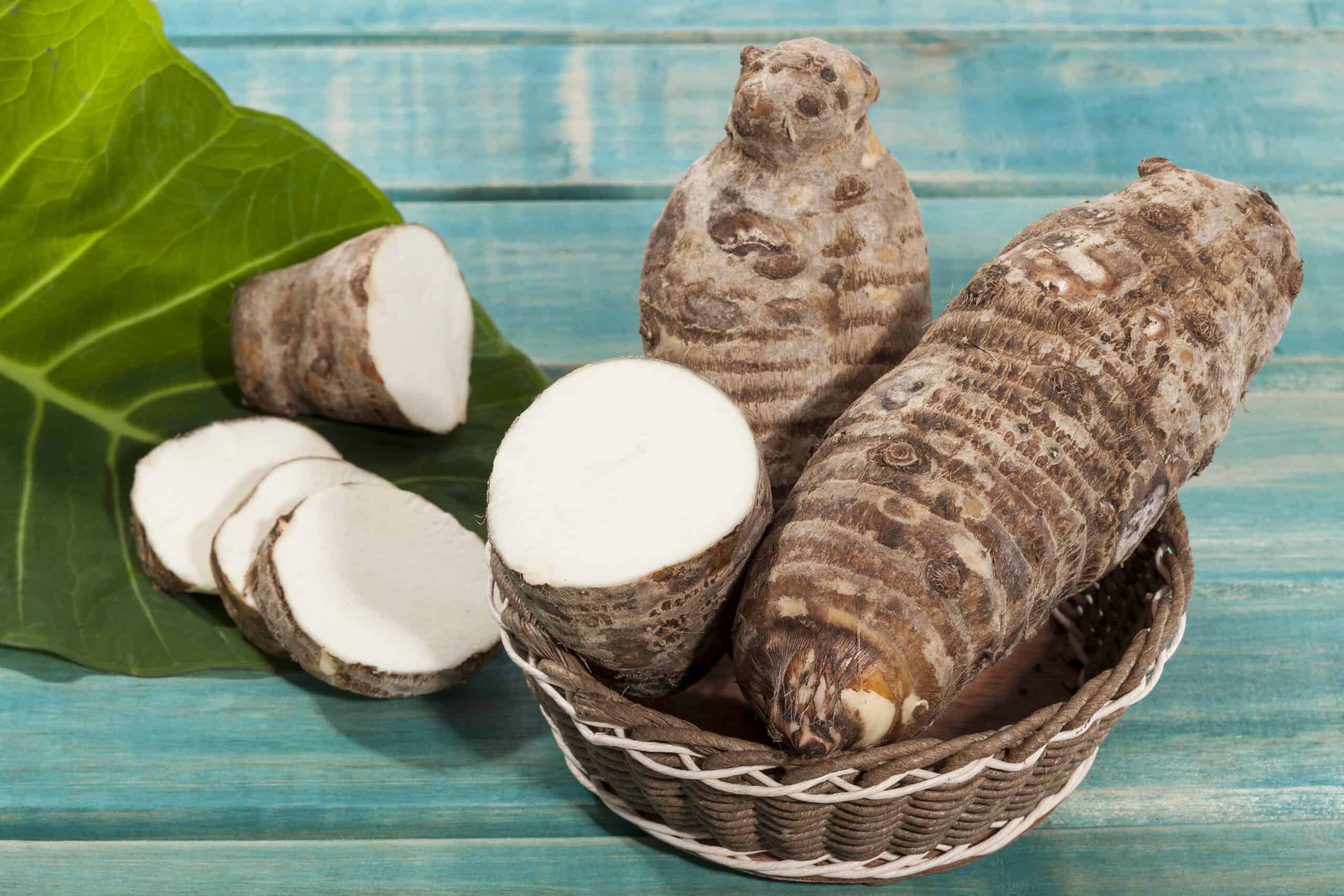
4. Mallow
Mallow is another one of those lesser-known veggies that start with M. Here is everything you need to know about it.
What Is Mallow?
Many people assume that mallow is just another weed. However, that’s not the case! Belonging to the same family as marshmallows and hibiscus, these edible plants have a long history in South African holistic medicine. This leafy vegetable is considered to be a medicinal herb, a nutritional powerhouse, and an ancient aphrodisiac – all in one!
What Does Mallow Taste Like?
Most folks don’t eat mallow for the taste, as it has an almost nonexistent and very mild flavor. Just like tofu, expect mallow to sop up the flavor of whatever you season or dress it with.
Is Mallow Healthy?
If mallow has such a bland flavor, why eat it? Well for starters, it has an excellent nutritional profile! Mallow is a good source of vitamins, specifically vitamins A, B, and C, as well as minerals like potassium, calcium, and magnesium. In fact, mallow’s tender young leaves have one of the highest vitamin A contents of all the M-letter vegetables.
Recipes To Try!
The leafy parts of the plant have a mucilaginous quality (kind of like okra) that is great for thickening soups and stews. You can also saute mallow like any other leaf vegetable or toss it in with your salad greens. Try it in these recipes:
5. Mangetout
Ever heard of mangetout? This vegetable name starting with M is a type of pea that is known for being picked at a young age. Here’s the scoop.
What Is Mangetout?
Like a younger version of sugar snap peas, mangetout peas (aka snow peas) are purposefully picked prematurely so that the pods remain flat and the peas are underdeveloped. Mangetout is popular in the United Kingdom, where they are in season from June to September.
What Does Mangetout Taste Like?
Mangetout has that signature, sweet pea taste. Its mild, sweet flavor is coupled with some zesty ‘green’ notes.
Is Mangetout Healthy?
Mangetout peas are incredibly high in vitamin C. They also have hefty doses of vitamin A and fiber.
Recipes to Try!
This green vegetable is a terrific healthy snack idea. I love eating them fresh with soy sauce or you tossing them in my favorite stir fry recipe. Here are some great options:
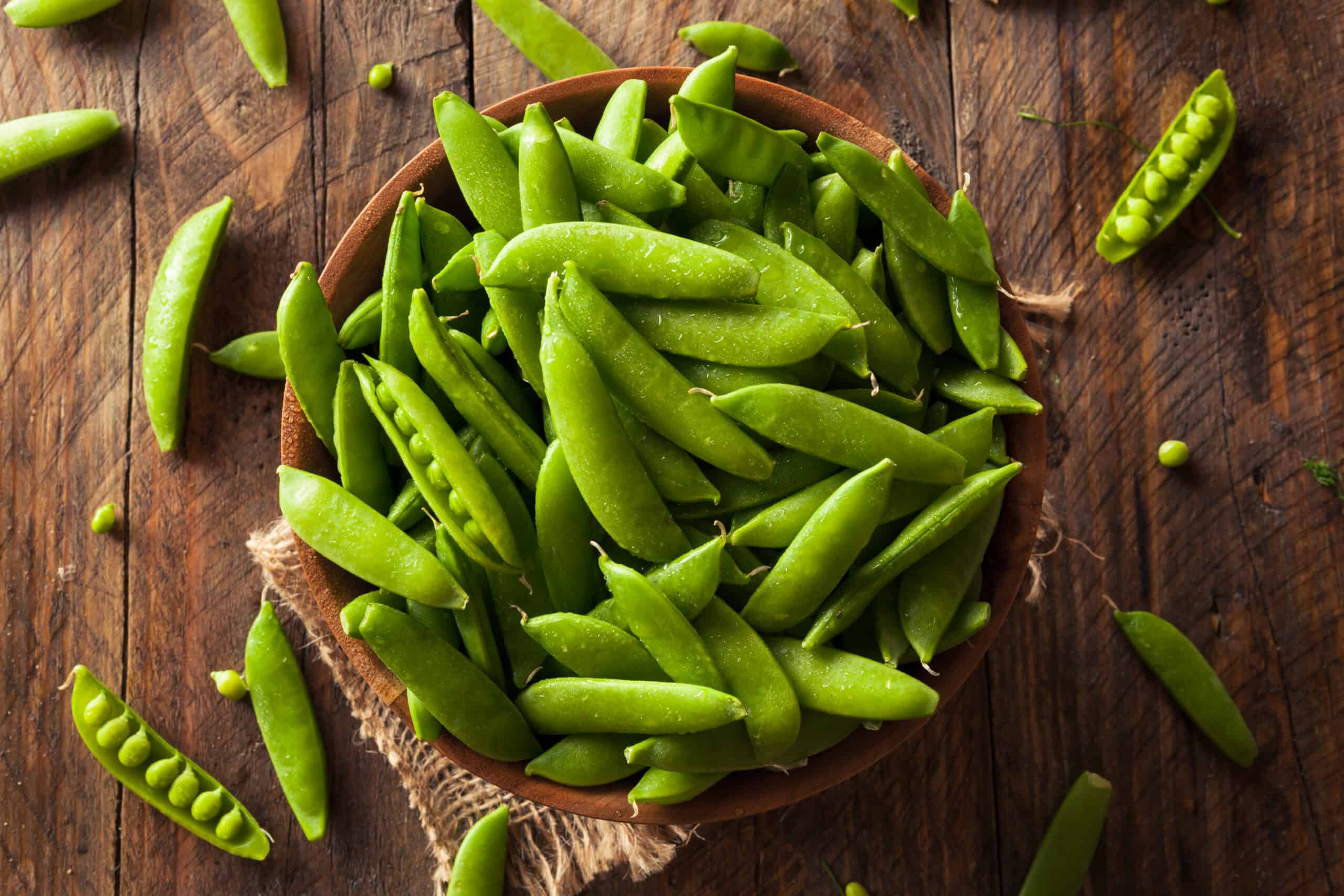
6. Manoa
Sure, we’ve all heard of bibb, romaine, and iceberg lettuce. But are you familiar with Manoa lettuce? This lettuce type is widely grown in regions with a tropical climate, like the islands surrounding Hawaii and other tropical areas.
What Is Manoa Lettuce?
Manoa lettuce is classified as being of the semi-head variety. This veggie has medium-sized, deep-green leaves that some people refer to as “butter lettuce leaves.” In a nutshell, Manoa is crisp, tender, and grows a compact, 8-inch head.
What Does Manoa Lettuce Taste Like?
Manoa lettuce has a sweet and somewhat buttery taste. Additionally, its crisp texture puts it on the juicier side, similar to Bibb lettuce.
Is Manoa Lettuce Healthy?
Manoa’s green leaves are a great source of folate, vitamin A, and vitamin C.
Recipes To Try!
Manoa lettuce is ultra-versatile and one of the most delicious vegetables that start with m. I recommend using it as you would romaine or butter lettuce. Personally, I love adding it to a stir fry a la bok choy or choy sum. Alternatively, you could toss it into one of these tasty recipes:
7. Marrow
Marrow refers to several varieties of tender and thin-skinned summer squash. The term ‘marrow’ is widely used in the United Kingdom, but people in the United States are still more likely to refer to these vegetables as summer squash or zucchini.
What Are Marrow?
Marrow is a category of elongated, creamy squash that is oval in shape and greenish in color. Indigenous to Central America, marrow vegetables are most often used in savory dishes.
What Does Marrow Taste Like?
Marrow has a relatively bland flavor and creamy flesh. For these reasons, it is a fabulous accompaniment to many different types of vegetables.
Is Marrow Healthy?
While it’s not the most nutritious of vegetables that begin with M, marrow is rich in potassium. Studies have linked consuming marrow to weight loss, improved eyesight, stronger bones, improved immunity, and enhanced blood circulation.
Recipes To Try!
As I mentioned, the most common uses for marrow are savory dishes. Try adding some to these delicious recipes:
- Stuffed Vegetarian Zucchini Pizza Boats
- Courgette Chips with Parmesan (Baked Zucchini Chips)
- Vegan Zucchini Muffins
8. Mashua
These edible tubers originate in South America. While Mashua was once primarily used for medicinal purposes, it is now used in a variety of cuisine.
What Is A Mashua?
Mashuas are some of the most uniquely delicious vegetables beginning with the letter M. They look a bit like potatoes, and both the tubers and flowers can be cooked or enjoyed raw.
What Does Mashua Taste Like?
When eaten raw, mashua has a tangy flavor that resembles a refined, intensely aromatic horseradish. If you boil or steam them, mashuas will lose their spiciness, though they retain their sharp, peppery flavor.
Is Mashua Healthy?
Mashuas are jam-packed with vitamins and essential nutrients, specifically vitamin C. They are also a good source of protein, fiber, and carbohydrates.
Recipes To Try!
When it comes to mashua, all parts of plants can be enjoyed raw or cooked. So, if you’re looking for some recipe inspiration, you’ve come to the right place! Try swapping potatoes for mashuas in these recipes:
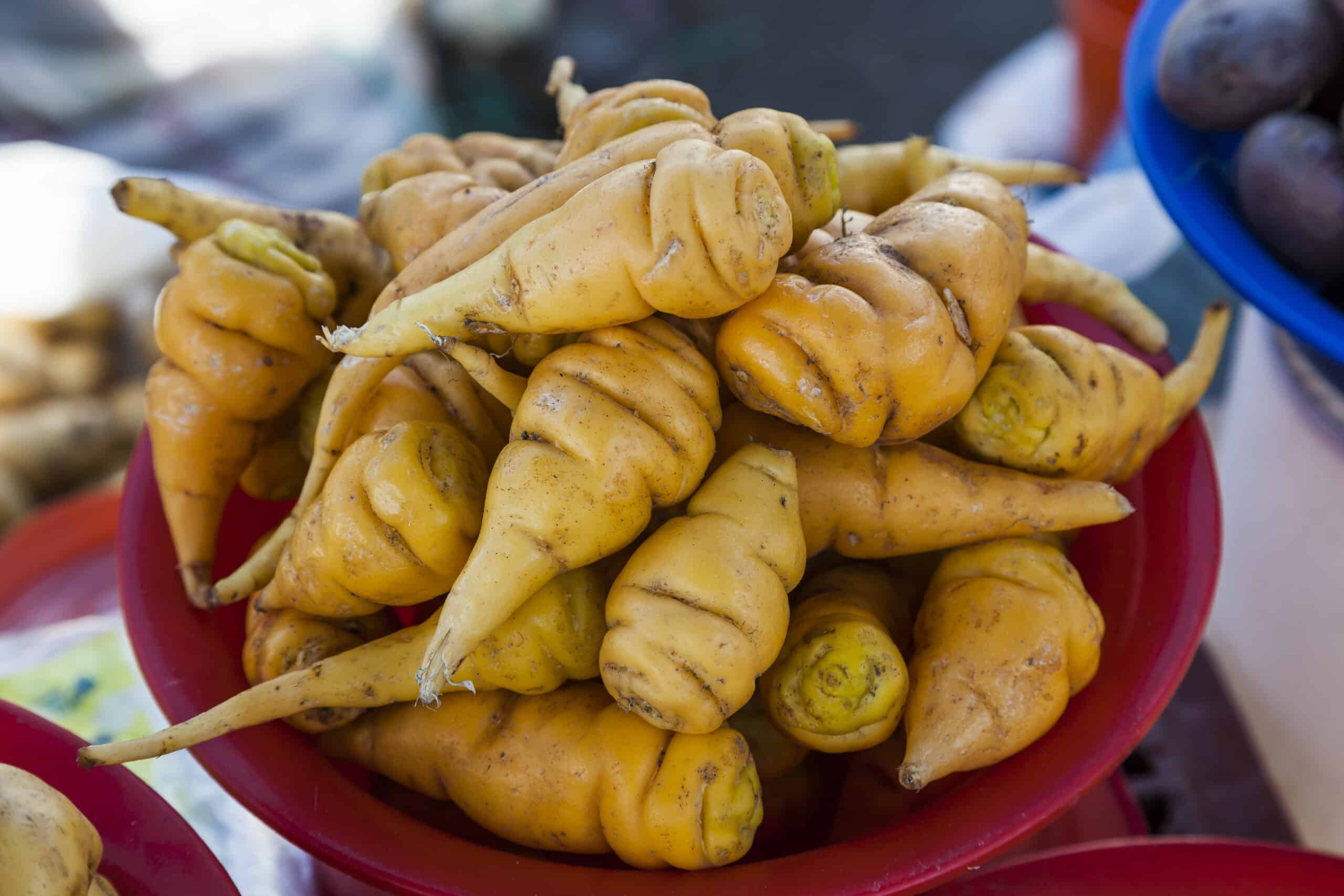
9. Miner’s Lettuce
Miner’s lettuce can attribute its name to the gold miners who used to eat it as a hearty, great snack of salad greens. Because Miner’s lettuce is a tremendous source of vitamin C, it was (and still is!) known for staving off disease.
What Is Miner’s Lettuce?
Originating in North America, you can find Miner’s lettuce anywhere from southern British Columbia to Arizona. (Think: the American Gold mine region.)
What Does Miner’s Lettuce Taste Like?
Miner’s lettuce is pleasantly crunchy and mild tasting, has large leaves, and remains tender even when it’s flowering.
Is Miner’s Lettuce Healthy?
Miner’s lettuce is loaded with vitamin C (one-third of your daily requirement, to be exact), which is why miners ate it to cure and prevent scurvy disease. It’s also a tremendous source of vitamin A and iron.
Recipes To Try!
I love using this type of lettuce as a nutrient-dense way of finishing off salads. Try tossing some atop these delicious salad recipes:
10. Mizuna Greens
Mizuna greens (aka Japanese mustard greens) are staple vegetables in South Asia and Southeast Asia.
What Are Mizuna Greens?
Sharp, spicy, bright, and beautiful, these veggies are a chef’s dream! Mizuna greens have a distinct flavor profile and are wonderfully decorative with their serrated edges and glossy surface.
What Do Mizuna Greens Taste Like?
As a cross between arugula and mustard, this vegetable that starts with m has an incredibly unique, spicy, and bright flavor. They are commonly used in Japanese dishes, oftentimes being served as an appetizer, with rice, or as a garnish for beer.
Are Mizuna Greens Healthy?
Yes! Thanks to their lush green color and abundance of chlorophyll, Mizuna is rich in vitamins A, C, K, and beta carotene.
Recipes To Try!
Mizuna greens are best served with Asian-inspired dishes like these recipes:
- Teriyaki Noodles (Vegan + Gluten Free Option!)
- Thai Basil Eggplant Recipe (Vegan Stir Fry)
- Tofu Broccoli with Sesame Noodles: Healthy and Vegan
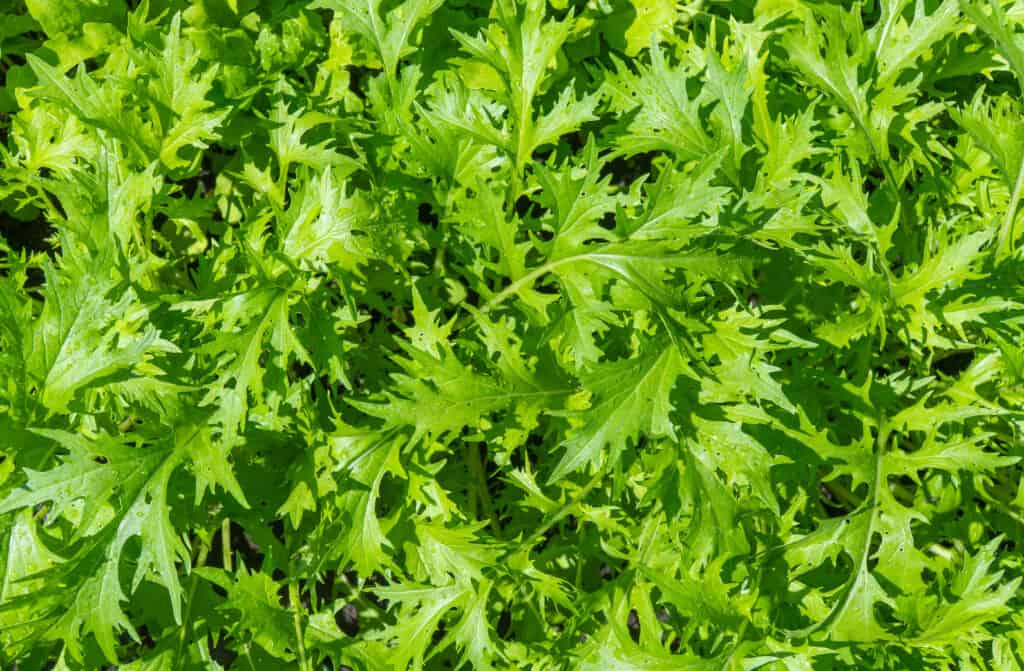
11. Molokhia
Molokhia (aka Egyptian spinach) is a leafy vegetable popular in the Middle East. Another more common name for this veggie is the jute leaf.
What Is Molokhia?
Originating in Ancient Egypt, Molokhia is a vitamin-rich superfood that is considered to be a phenomenal sleep and digestion aid. If you’re unfamiliar with the veggie, think of Molokhia like you would collard greens, commonly served as a dish of braised greens over rice.
What Does Molokhia Taste Like?
The best way to describe Molokhia is earthy. Although it looks a lot like spinach, the flavor and texture of Molokhia are unique. For mouthwatering results, I recommend garnishing this dish with fresh garlic and juice from a lemon or another citrus fruit.
Is Molokhia Healthy?
Thanks to its many vitamins and minerals, molokhia is incredibly good for you. In fact, consuming molokhia is linked to lower blood pressure, improved circulation, digestion aid, lower cholesterol, insomnia relief, better immune health, and even cancer relief.
Recipes To Try!
Want to taste this vegetable that starts with m for yourself? Swap the spinach for molokhia in this Mushroom Toast with Spinach and Roasted Garlic recipe.
12. Morels
Morels are one of the most widely recognized kinds of edible mushrooms. Referring to their brown color, some people say that they get their name from the word “moor.”
What Are Morels?
Morels are a wild type of mushroom that grows in the calcareous and acid soil of New Hampshire. They have brown, spongey, honeycomb-like caps, and boast several sub-species (brown, black, yellow, etc.). Thanks to their savory flavor and rarity, morel mushrooms are highly prized in the culinary world and can be found at your local grocery store.
What Do Morels Taste Like?
Unlike the majority of mushrooms (that have a robust, meatier taste), morels have a subtle flavor when cooked. Unlike portabella or white button mushrooms, morels are often described as having an earthy, woody, and slightly nutty flavor.
Are Morels Healthy?
It is only safe to consume morels once they are cooked. Once cooked, morels have an excellent nutritional profile. They carry the highest vitamin D content of all edible mushrooms and are renowned for their rich mineral content.
Recipes To Try!
Morels can be stewed, braised, or cooked in main dishes. I love sauteeing these m vegetables with butter and garlic, but you can also try swapping them in these recipes:
- Rustic Pizza Recipe with Garlic and Mushrooms
- Vegan Wellington
- Chili Stuffed Peppers with Black Beans and Mushrooms
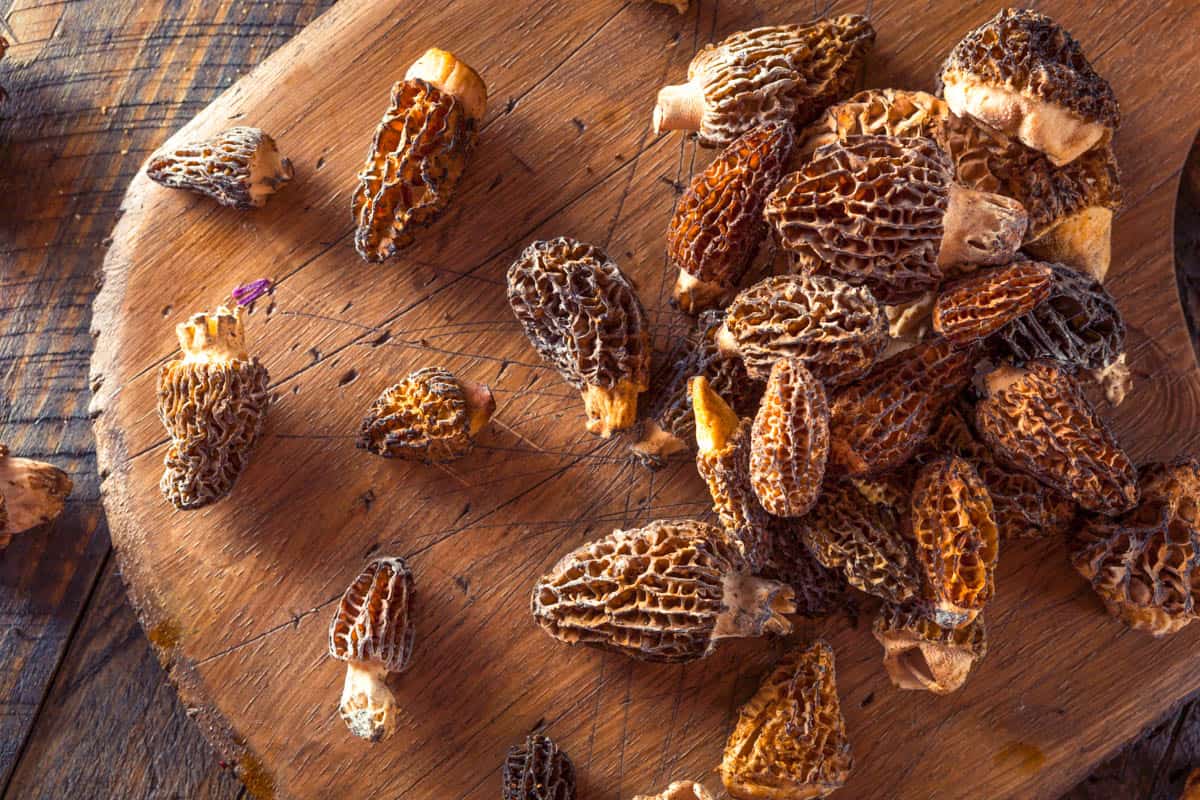
13. Moth Beans
Moth beans (aka dew beans) are small, light brown, and incredibly popular in Indian cuisine.
What are Moth Beans?
Like other legumes, moth beans are a tremendous source of protein. Used frequently in Indian dishes, these types of beans are small, oblong in shape, and have an earthy, somewhat nutty flavor. Moth beans make a great snack and can also be used to add some nuttiness to main or side dishes.
What Do Moth Beans Taste Like?
Moth beans have a nutty, somewhat sweet taste. They are typically used to enhance main dishes and side dishes in Indian cuisine.
Are Moth Beans Healthy?
Although they are tiny, these mighty legumes are loaded with protein and complex carbohydrates.
Recipes To Try!
I would be lying if I said moth beans weren’t just a little bit tough to cook. Before you do anything, soak them for 6+ hours overnight. Then, try adding this vegetable that starts with m to these recipes:
14. Mozuku
Essentially, Mozuku constitutes a list of vegetables that are better referred to as edible Japanese seaweed. This antioxidant-rich and anti-inflammatory veggie is a staple in Okinawa, Japan, which is home to the world’s longest-living people.
What Is Mozuku?
Mozuku is an edible form of algae that is a culinary staple along the shores of the Blue Region of Okinawa, Japan. Unlike its blue or green counterparts, this brown seaweed contains fucoidan, which is known to provide a multitude of health benefits.
What Does Mozuku Taste Like?
Mozuku has a light and simple taste that will probably remind you of, well, seaweed. It has a bit of a sea smell, and its texture reminds me a bit of wakame, which is a tad chewy. All in all, I would say that Mozuku tastes like the sea.
Is Mozuku Healthy?
Is there a link between this dietary staple and the Okinawa people sporting the longest lifespan? Most dieticians will say probably. Okinawa seaweed is nutrient dense and considered a superfood. Fucoidan, specifically, has antioxidant, anti-tumor, anti-coagulant, anti-thrombotic, anti-viral, and anti-inflammatory effects. Additionally, seaweed is a natural form of iodine, which is a nutrient that supports thyroid health.
Recipes To Try!
To maximize its health benefits, these vegetables that start with m are best enjoyed raw, dressed with sweet vinegar, or paired with other gut-healthy ingredients. However, some like to deep-fry it or toss it into soups. To get you started, I would recommend enjoying a bowl of raw Mozuku as an appetizer or side dish for these recipes:
- Tofu Broccoli with Sesame Noodles: Healthy and Vegan
- Tofu Skewers with Ginger Soy Marinade
- Vegetarian Egg Roll in a Bowl
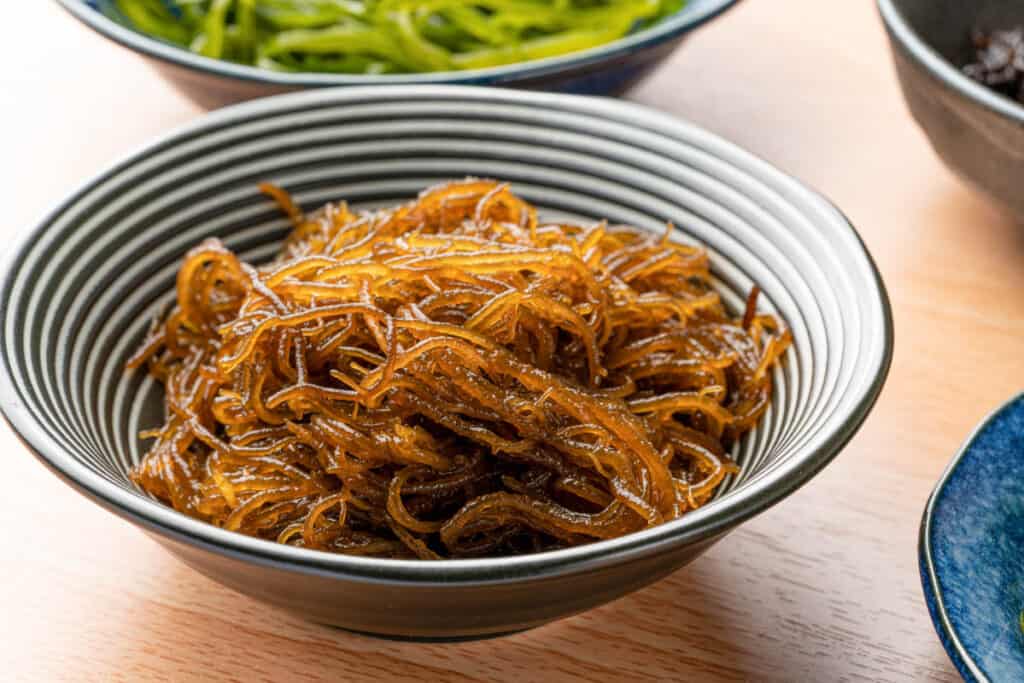
15. Mulukhiyah
This classic Middle Eastern comfort food veggie is soupy, wholesome, and features a distinctive leafy green taste.
What Is Mulukhiyah?
A hallmark of Middle Eastern cuisine, Mulukhiyah are leafy greens commonly referred to as Jew’s Mallow. It is delicious, cozy, and traditionally prepared as a soup with chicken broth.
What Does Mulukhiyah Taste Like?
Every region prepares Mulukhiyah a bit differently. However, I love preparing it with homemade vegetable stock, whole spices, and other veggies. The result is a highly flavorful, almost garlicky broth that somewhat resembles okra or a marvelous green gumbo.
Is Mulukhiya Healthy?
Yes! Mulukhiya’s many vitamins and minerals make this food a healthy addition to any diet. Specifically, eating Mulukhiya can be linked to low blood pressure, improved circulation, aided digestion, relieving insomnia, lowered cholesterol, boosted immune health, and even a reduced risk of cancer.
Recipes To Try!
Mulukhiya is the main dish in itself, although you can serve it with pickled red onions or over a bowl of your favorite rice.
16. Mung Beans
These green beans are nutritious, easy to cook, and delicious. Here’s a simple breakdown of this tasty M vegetable.
What Are Mung Beans?
Mung beans are small legumes that belong to the bean and lentil family. They are cultivated in China, Sri Lanka, India, Pakistan, Korea, and Southeast Asia. Typically, mung beans refer to the whole, intact bean that can be found encased inside its husk. However, sprouted mung beans also work great in sandwiches and wraps.
What Do Mung Beans Taste Like?
Mung beans have a slightly sweet, nutty flavor and can be cooked on the stovetop like any other kind of dried bean.
Are Mung Beans Healthy?
They sure are! Mung beans are a fantastic source of folate, dietary fiber, protein, phosphorus, iron, copper, magnesium, manganese, and vitamin K. This protein and fiber combo makes them truly a nutritional powerhouse.
Recipes To Try!
You can cook this m vegetable on the stovetop, in an Instant Pot, or in a slow cooker. I recommend enjoying them alongside these dishes:
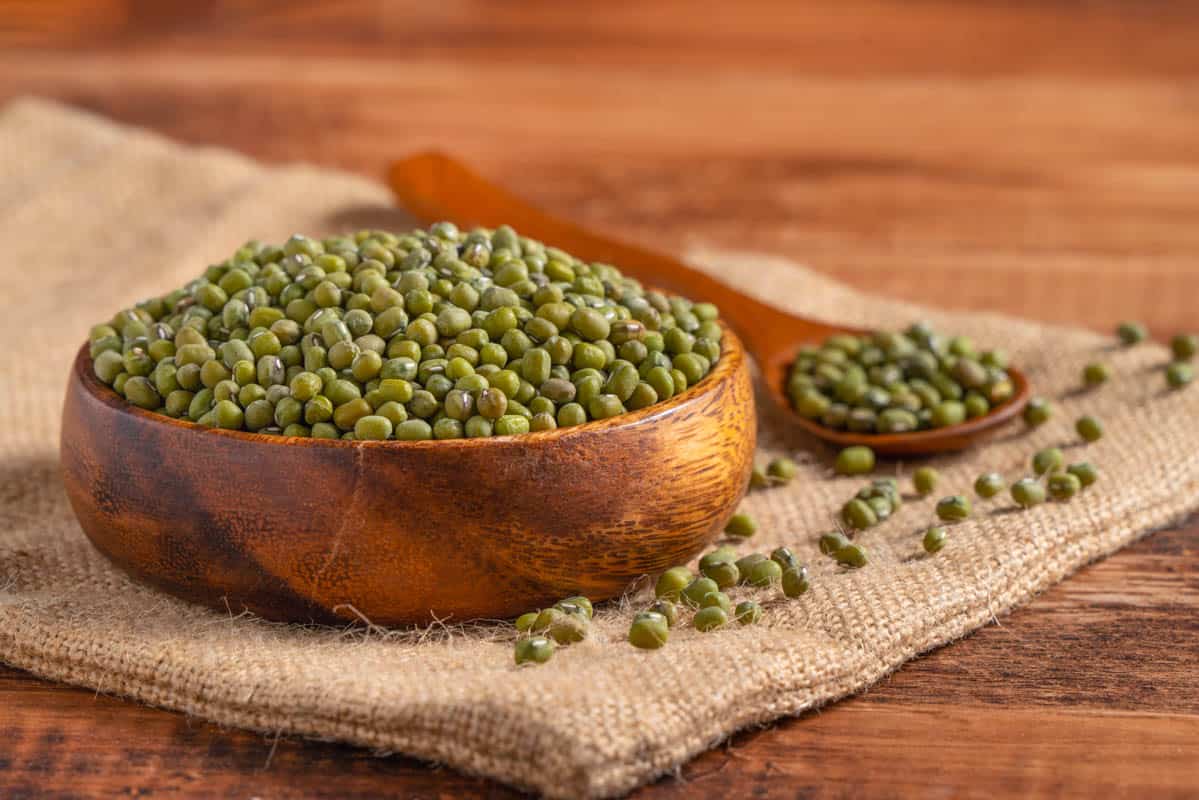
17. Mushrooms
It would be silly not to include mushrooms on our list of vegetables that start with M. While this diverse food source encompasses many different kinds of mushrooms (all with varying compositions, textures, and flavors), all edible types of fungi have excellent nutritional values.
What Are Mushrooms?
Mushrooms have been eaten and used for their medicinal properties for thousands of years. While they are neither plant nor animal food, fungi contain modest amounts of fiber and nutritional ingredients. Additionally, culinary chefs love them for their ability to create that savory, umami flavor.
What Do Mushrooms Taste Like?
Mushrooms capture that strong, umami flavor. For this reason, they make an excellent meat substitute. Additionally, some might describe mushrooms as having an earthy, slightly woodsy, and meaty flavor.
Are Mushrooms Healthy?
Mushrooms have been used as a medicinal tool around the world for centuries. Research suggests that the plant chemicals and components in mushrooms exert antioxidant, anti-inflammatory, and anticancer effects. Mushrooms also contain B vitamins, phosphorus, and vitamin D.
Recipes To Try!
There is a multitude of ways to enjoy these vegetables that start with m – raw, sauteed, grilled, and more! If this sounds overwhelming to you, here are some of my favorite mushroom recipes to get you started:
18. Mustard
I’m sure you have heard of mustard, America’s favorite hot dog condiment. However, are you familiar with where it comes from? If you think mustard might come from a plant, then you’re absolutely correct.
What Is Mustard?
The mustard plant produces mustard seeds, which are then ground into a spice. If you mix those ground seeds with water, vinegar, or another liquid, it produces that yellow condiment that we all know as mustard.
What Does Mustard Taste Like?
Mustard has a peppery taste that ranges from sweet to spicy. Because it is frequently used in mixtures, this versatile condiment can take on a variety of flavors. While different people use mustard for different things, it is most commonly paired with meats, veggies, and cheeses.
Is Mustard Healthy?
Mustard is a relatively healthy condiment that contains plenty of vitamins and essential minerals. It is linked to increased metabolism, cancer prevention, lower blood pressure, soothing sore throats, and several other health benefits.
Recipes To Try!
Looking for new ways to enjoy this tasty condiment? Here are some delicious variations:
19. Mustard Greens
Mustard seeds aren’t the only thing the mustard plant provides us! Mustard greens are another name for the peppery leafy greens of the same plant. Here’s everything you should know about them.
What Are Mustard Greens?
Related to kale and cabbage, mustard greens are essentially the green leaves of the mustard plant. These leafy green veggies are used frequently in Chinese, Japanese, and Indian cuisine.
What Do Mustard Greens Taste Like?
Mustard greens aren’t as bitter as kale or collard greens. In fact, they actually taste a bit peppery, like arugula. Additionally, many people say they taste a bit like spinach once they’re cooked.
Are Mustard Greens Healthy?
Mustard greens contain plenty of health-boosting antioxidants like beta carotene. They also contain significantly more vitamin C than spinach and feature a wide variety of other essential vitamins and minerals.
Recipes To Try!
For mouthwatering results, try sauteeing mustard greens with olive oil, garlic, and a dash of sesame oil or soy sauce. You could also try adding them to these tasty recipes:
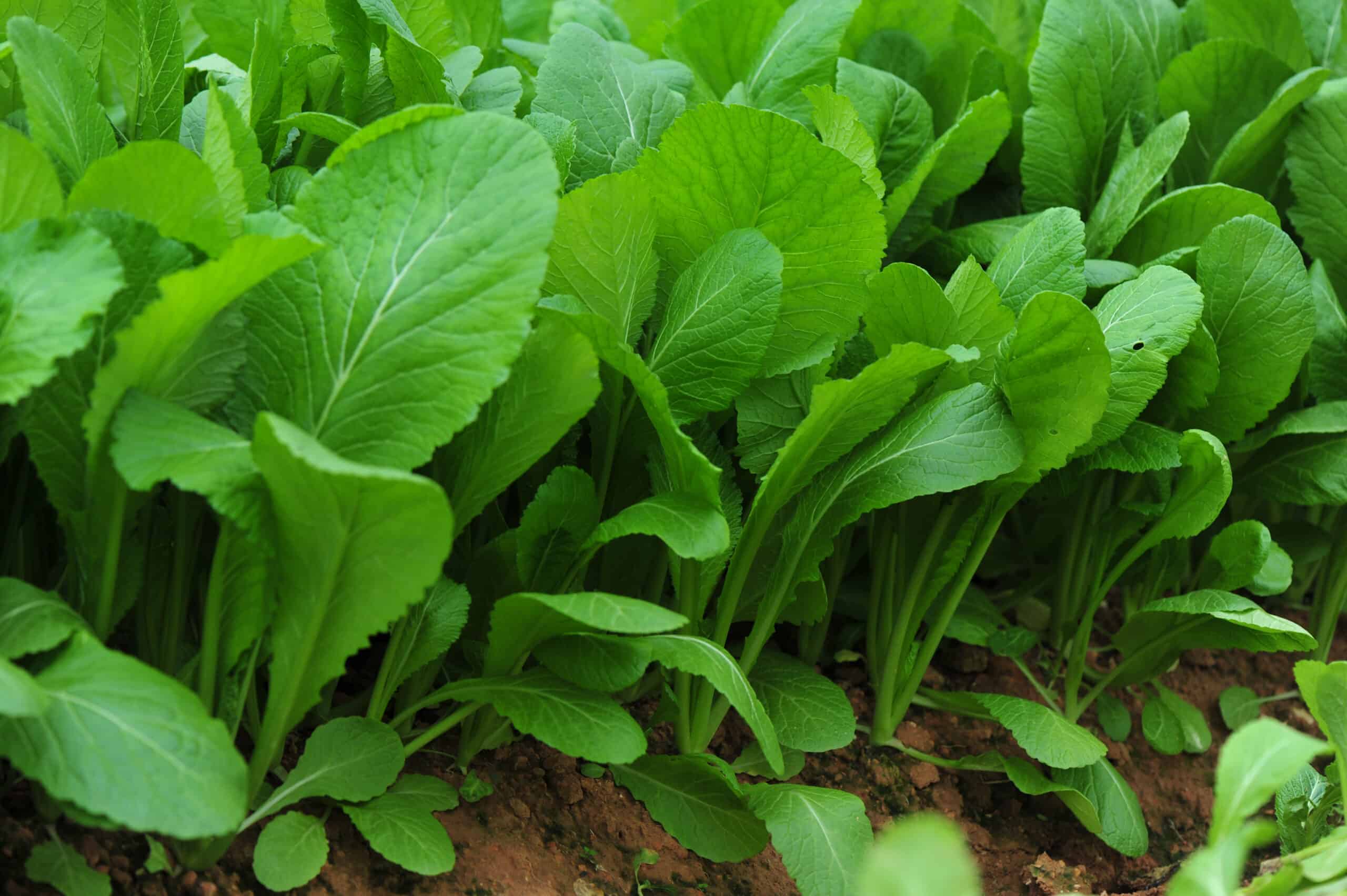
More Helpful Food Guides!
- Foods That Start With L
- Foods That Start With X
- Foods That Start With T
- Foods That Start With U
- Foods That Start With F
- Vegetables That Start With L
- Fruits That Start With O
- Fruits That Start With L
- Foods That Start With I
- Fruits That Start With Q
Final Thoughts
As you can see, there are lots of names of vegetables that start with the letter M! Hopefully, this guide was able to help you familiarize yourself with some new vegetables and inspired you to put a unique spin on some of your old favorites.
Did I miss your favorite M vegetable? Let me know in the comment section and keep checking in with my blog to stay up-to-date on the latest A-Z eating guides, and to continue exploring the many unique fruits and veggies our amazing planet has to offer!












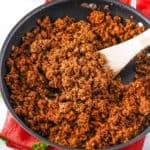
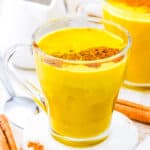









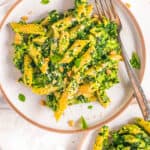
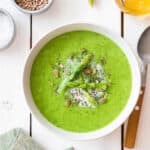






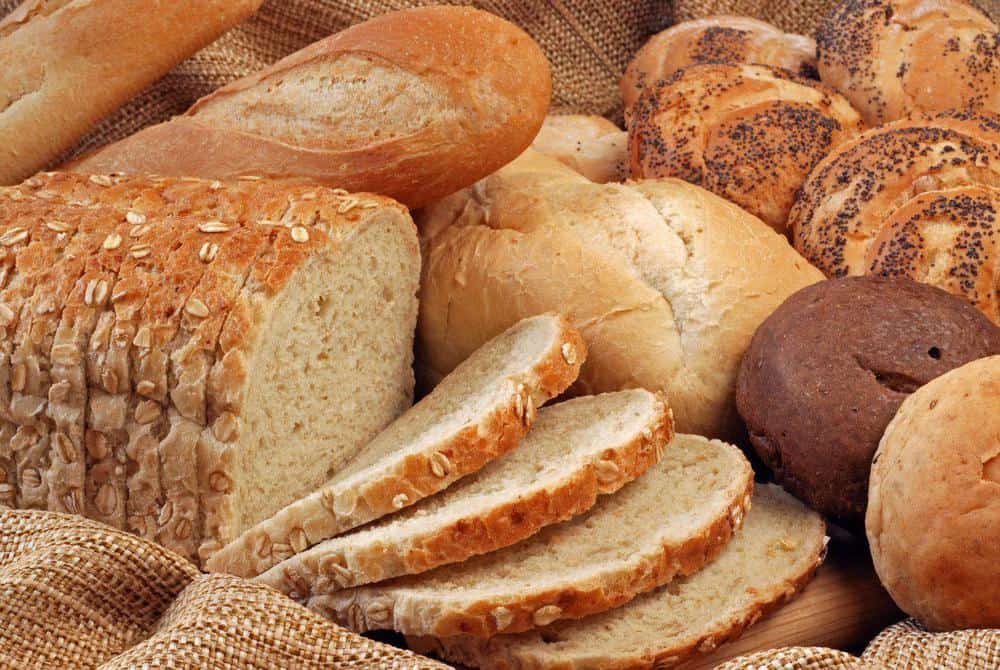
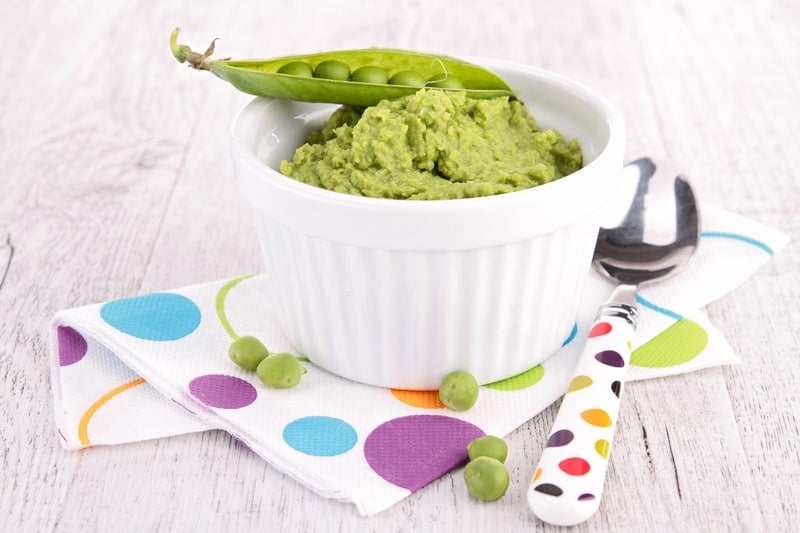
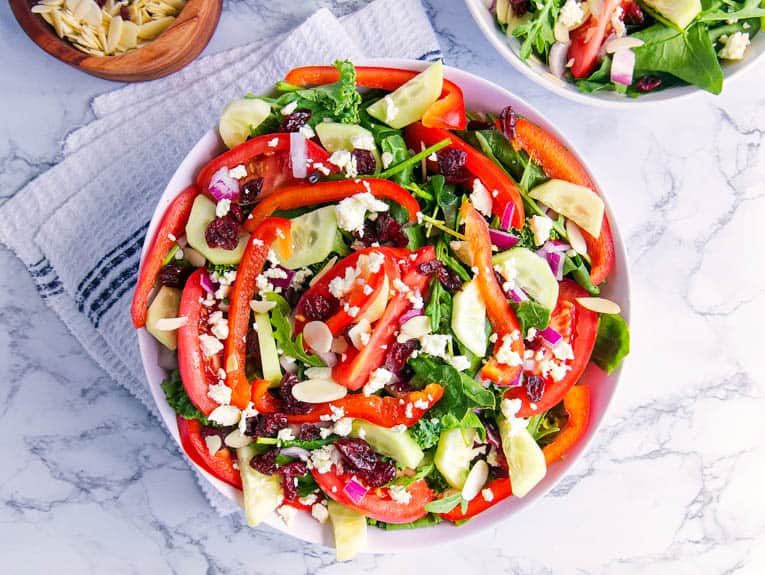


This is such a fun collection of veggies and recipes! What a great idea. 🙂
Thanks so much Carrie!
This is such a cohesive list! Thanks so much for sharing!
Thanks Tayler – glad you found it useful!
So much great information! Thank you for all the details.
For sure! Glad it was helpful!